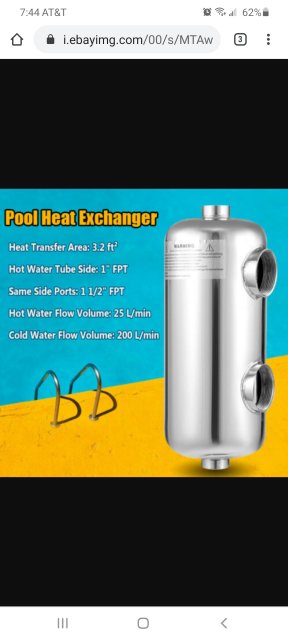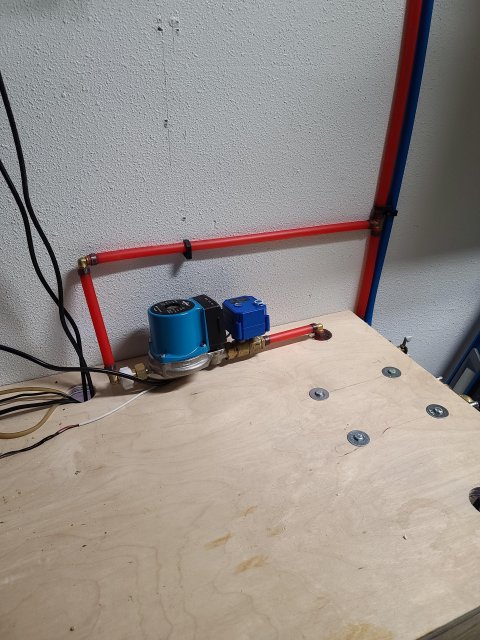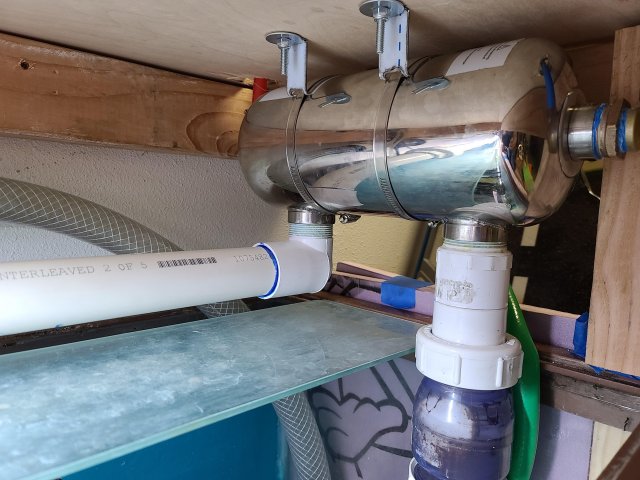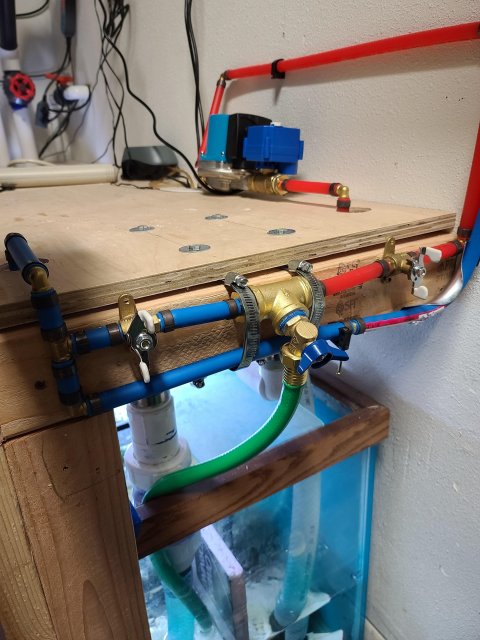So, now that the 580g tank has been up and running for 3 months now, I want to figure out something different for heat. I am currently running 3 Eheim 300w heaters and its running me about $75-$90 per month. Being a person who loves tinkering on stuff, I've decided to build a hot water loop to heat the system. The sump is located in the garage, and I've got 1" foam insulation on all sides of the sump and 1/2 of the top. I've decided to go with a heat exchanger rather than run a coil of tubing in the sump. I plan on using an inkbird controller to run the pump and an electronic ball valve as a safety. I will also have a second inkbird hooked up to 2 300w heaters set 4 degrees cooler as an emergency backup should something go wrong. I have done a bit of googling and pretty much have my plan drawn out, but I was wondering if anyone here has any advice or lessons learned on doing a similar thing...... Thanks in advance.
DIY Hot water heater
- Thread starter hartebreak
- Start date
You are using an out of date browser. It may not display this or other websites correctly.
You should upgrade or use an alternative browser.
You should upgrade or use an alternative browser.
The room where the display tank is located is kept at 72*. The tank is running at 80*, the tank is plywood so it is pretty well insulated. I think the sump is where most of my heat loss is. My garage is usually around 40* in the winter which obviously is pretty chilly. I'm sure the insulation around the sump helps, but according to my rudimentary figuring, Its costing my about $3/day to heat the tank currently, and doing the hot water loop to my natural gas water heater, Im looking at about $0.35/day.
Is your water heater gas or electric? If your water heater is electric using it to heat your aquarium will not save you any money. Electric heaters are 100% efficient (all the energy from the electrical ccurrent is converted into heat). Piping water from your water heater to your tank will have some parasitic heat loss through the lines carrying the water lowering the overall efficiency from what you have now.
Natural gas water heaters are less efficient than electric water heaters BUT natural gas is usually considerably less expensive than electricity when used for heating so you could potentially save money using a natural gas water heater to heat your tank.
Natural gas water heaters are less efficient than electric water heaters BUT natural gas is usually considerably less expensive than electricity when used for heating so you could potentially save money using a natural gas water heater to heat your tank.
Last edited:
My water heater is gas. And here in Oregon, gas is very cheap compared to electricity.Is your water heater gas or electric? If your water heater is electric using it to heat your aquarium will not save you any money. Electric heaters are 100% efficient (all the energy from the electrical ccurrent is converted into heat). Piping water from your water heater to your tank will have some parasitic heat loss through the lines carrying the water lowering the overall efficiency from what you have now.
Natural gas water heaters are less efficient than electric water heaters BUT natural gas is usually considerably less expensive than electricity when used for heating so you could potentially save money using a natural gas water heater to heat your tank.
My water heater is gas. And here in Oregon, gas is very cheap compared to electricity.
I am in Central Oregon, Redmond. Yes, natural gas rates here are very good. Unfortunately I don't have natural gas at my place. Heating your tank with natural gas should easily pay for the setup then save you considerable money.
What are you using for a heat exchanger? What is the base metal that the heat exchanger is made out of? What are you going to run for piping between the hot water heater and the tank? Pex? Do you really think the electric valve will be needed? I can definitely understand that it is cheap insurance and piece of mind to keep your tank from over heating! An electric ball valve is what I would use too.
Just mapping a system like that out in my head. If you didn't have a cut off valve the most likely problem would be cold water being pushed through the loop due to a pressure differential when someone is using a lot of hot water, like a shower. That could actually induce a cooling effect in your tank instead of heating. You could get around this with a 1 way check valve and not use an electric ball valve. Just postulating, I won't give you a hard time for using an electric ball valve for cheap insurance!
Last edited:
I am using a stainless steel exchanger made for a swimming pool. I plan to run the electric valve off a 2nd heat controller as a safety. The valve is normally closed, so if power goes out the valve will close. For pipe, I am using pex and will have insulation on the pipe. Its not a huge distance from the water heater to the sump, probably about 12 feet, so heat loss will be minimal.


Very nice design!
Am I correct in assuming that the heat exchanger will be incorporated into the filtration loop of the tank? Will it be heating the water entering the sump or the presurized water leaving the sump and returning to the tank?
3.2 sq feet of stainlless steel heat exchange area should offer a very high potential rate of BTU transfer from the closed loop to the aquarium water depending on the temperature difference between the water heater and the aquarium... which should be quite large. It would seem like the heating system could very rapidly change the temperature of your aquarium? Could you regulate the heat exchange rate of the system by using a variable flow pump on the closed loop of the system? By changing the flow rate of the closed loop you would vary how fast the aquarium will heat up. I would speculate that the slower the heat exchange rate the easier it will be to keep a constant temperature in the aquarium minimizing hot and cold swings?
Eventually deposites will build up on both sides of the heat exchanger plate which will lower the efficiency of the heat exchanger. When this eventually happens you would be able to increase the heat exchange rate by increasing the flow of the loop pump.
Am I correct in assuming that the heat exchanger will be incorporated into the filtration loop of the tank? Will it be heating the water entering the sump or the presurized water leaving the sump and returning to the tank?
3.2 sq feet of stainlless steel heat exchange area should offer a very high potential rate of BTU transfer from the closed loop to the aquarium water depending on the temperature difference between the water heater and the aquarium... which should be quite large. It would seem like the heating system could very rapidly change the temperature of your aquarium? Could you regulate the heat exchange rate of the system by using a variable flow pump on the closed loop of the system? By changing the flow rate of the closed loop you would vary how fast the aquarium will heat up. I would speculate that the slower the heat exchange rate the easier it will be to keep a constant temperature in the aquarium minimizing hot and cold swings?
Eventually deposites will build up on both sides of the heat exchanger plate which will lower the efficiency of the heat exchanger. When this eventually happens you would be able to increase the heat exchange rate by increasing the flow of the loop pump.
I forgot to give an update on this. Got everything plumbed in and installed. I have 1 improvement I am in the middle of which is adding a 2nd electronic ball valve which is in the normally open position which I will plug into a second inkbird which will be set at 78* which is 3* under the tank temp. Currently, if my natural gas hot water heater happened to go out, nothing would prevent the system from pumping 50* water thru the heat exchanger until realized there was an issue (most likely dead fish). With the new valve, if the primary temp sensor is calling for heat and my water heater is putting out cold water, once it drops to 78* the valve will close thus preventing the continued loss of heat. The second controller will simultaneously kick on the 2 300w heaters I left in the sump as backup.
Since I was doing some plumbing anyway, I also added a hose bib with hot and cold with individual valves so I can set a perfect temp for hoseless water changes. I've had it up and running for about 3 weeks now and Im super happy with how its working

 . Once calling for heat, this system will raise the temp about 1 degree in 15 minutes. The new electronic ball valve should be here on Wednesday and I will complete the installation and clean up the wiring etc.
. Once calling for heat, this system will raise the temp about 1 degree in 15 minutes. The new electronic ball valve should be here on Wednesday and I will complete the installation and clean up the wiring etc.
Since I was doing some plumbing anyway, I also added a hose bib with hot and cold with individual valves so I can set a perfect temp for hoseless water changes. I've had it up and running for about 3 weeks now and Im super happy with how its working


 . Once calling for heat, this system will raise the temp about 1 degree in 15 minutes. The new electronic ball valve should be here on Wednesday and I will complete the installation and clean up the wiring etc.
. Once calling for heat, this system will raise the temp about 1 degree in 15 minutes. The new electronic ball valve should be here on Wednesday and I will complete the installation and clean up the wiring etc.Do you have a schematic or drawings of where everything is in this heat exchanging system? I've been thinking about doing this on my 400g tank but haven't bought the supplies yet. I'd love to hear what you think you'd change to make it better also.


